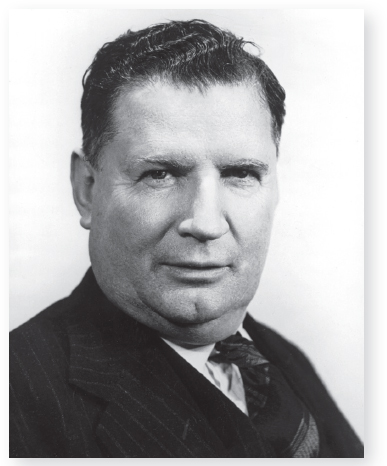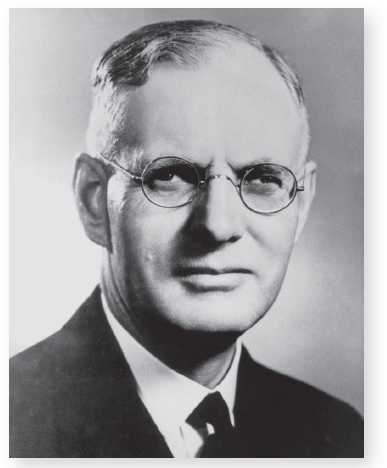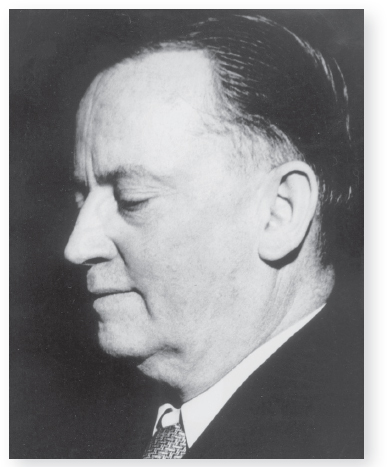First Among Equals (6 page)
Read First Among Equals Online
Authors: Kim; Derry Hogue; Wildman

Page was in opposition until 1934, when Joseph Lyons' new United Australia Party (UAP) was unable to form government without the support of the Country Party. Page became minister for commerce and the unofficial deputy prime minister from 1934 to 1939.
When Lyons suddenly died on 7 April 1939, Page became caretaker prime minister for twenty days, until the UAP elected Menzies as Lyons' replacement on 26 April 1939. Page, however, refused to serve under Menzies and vehemently attacked him in parliament, accusing him of disloyalty towards Lyons and cowardice for not having enlisted in World War I. The attack divided the Country Party and Page was subsequently forced to resign from its leadership.
By 1940, with their differences now behind them, Menzies appointed Page as minister for commerce. In 1941, however, Menzies was replaced as UAP leader and Country Party leader Arthur Fadden became prime minister. When Fadden's government fell in October 1941, Page was again relegated to the opposition backbench for the duration of the Curtin, Forde and Chifley Labor governments.
In 1949 when Menzies returned to power, Page was made the minister for health. He held this post until 1956, when, at the age of 76, he retired to the backbench. Just prior to the 1961 federal election, Page, now aged 81, was diagnosed with lung cancer. He subsequently died during the counting of votes on 20 December 1961, without ever knowing that he had lost his seat of Cowper after 42 years.

SIR ARTHUR WILLIAM FADDEN
THEY CALL ME âARTIE'
TERM
29 August 1941-7 October 1941
A
ustralia's thirteenth prime minister, Sir Arthur âArtie' William Fadden, often joked that his primeministership was like the Great Flood: it lasted â40 days and 40 nights'. While Fadden was not in power long enough to have any significant impact, his most important contribution to Australian politics was the preservation of the federal coalition partnership between the two conservative parties which has lasted more than 40 years.
Fadden was born on 13 April 1894, at Ingham in north Queensland. The son of Irish immigrants, Richard and Annie Fadden, he was educated at Walkerston Public School near Mackay. At the age of fifteen Fadden left school to work as a âbilly boy' on the canefields, before landing a job as an office boy at the Pleystowe sugar mill. By 1913 he had become assistant town clerk at the Mackay Town Council. Soon after, he began studying accountancy part-time and was eventually promoted to town clerk in 1916. Later that year he married Ilma Thornber, whose father had been mayor of Mackay.
After qualifying as an accountant in 1918, Fadden resigned from the council and set up practice in Townsville. In 1930 he became an alderman for the Townsville Council then, two years later, entered state politics winning the seat of Kennedy. In 1935 he lost his seat following an electoral redistribution. Fadden though, went on to win a by-election as the Country Party candidate in the federal seat of Darling Downs in 1936.
Fadden entered federal parliament during Joseph Lyons' term as prime minister. It was a period marked by turmoil with Lyons trying to hold together the United Australia Party's (UAP) coalition with the Country Party. But when Lyons suddenly died on 7 April 1939, then Country Party leader Earle Page, who served as caretaker prime minister for twenty days, clashed with the UAP's new leader, Robert Menzies. Page was forced to resign as leader of the Country Party and was replaced by Archie Cameron. When Menzies became prime minister, Cameron appointed Fadden as a party representative in the ministry.
Tragically, on 13 August 1940, three UAP ministers were killed when their plane crashed on approach to Canberra. Fadden was meant to have been on this flight, but had instead travelled by train. Ironically, Menzies then appointed Fadden the new minister for air and civil aviation.
With Labor fast regaining strength, the coalition barely survived September's federal election. Power struggles within the Country Party resulted in Cameron losing the leadership in a ballot in October 1940. With the vote then split between Page and McEwen, Fadden was appointed leader to break the deadlock. He then became treasurer, a member of the all-party Advisory War Council and acting prime minister when Menzies travelled to London in January 1941.
When Menzies returned to Australia in May 1941 he found the coalition dissatisfied with his leadership and conspiring against him. In August that year Menzies was forced out and, as the frontrunner in the UAP, Fadden stepped in as prime minister. With the Coalition still deeply divided, Fadden's government was defeated on the floor of the House of Representatives less than six weeks later when Labor's John Curtin moved against Fadden's budget. The governor-general appointed Curtin as his successor.
Fadden continued as opposition leader. In the 1943 election the conservative parties suffered major losses, enabling Menzies to rise again and seize control of the UAP leadership which he eventually renamed the Liberal Party. While Fadden's relationship with Menzies was a tenuous one, the two men built a strong Liberal-Country Party coalition which continues today. Thus, when Menzies was returned to power in 1949, Fadden was appointed treasurer and went on to deliver a record eleven budgets.
Fadden retired from politics in 1958 but failed to be appointed as chair of the Commonwealth Bank, as he had hoped. He was knighted in 1961 for his services to politics and worked on his autobiography,
They Called Me Artie,
which was published in 1969. Fadden died at his Brisbane home on 21 April 1973.

JOHN JOSEPH AMBROSE CURTIN
THE WAR PRIME MINISTER
TERM
7 October 1941-5 July 1945
W
idely regarded as one of Australia's greatest prime ministers, John Joseph Ambrose Curtin was the country's fourteenth prime minister and Labor's fifth federal leader. Coming to power during World War II, Curtin, a reformed alcoholic, faced an unprecedented and complex situation. Unfortunately, the stresses of war took their toll and on 5 July 1945 Curtin became the second prime minister to die in office.
The son of a police constable, Curtin was born at Creswick, Victoria, on 8 January 1885. The eldest of four children, he was educated at a series of public and private schools in Melbourne and various Victorian country towns, before his father's ill health forced him to retire and move the family back to Melbourne.
At the age of thirteen Curtin left school to help support his family. He worked briefly for both the
Age
and the
Rambler
newspapers before joining the Titan Manufacturing Company in 1903. During his time with the company, Curtin was influenced by Frank Anstey, then a member of the Victorian Legislative Assembly, and Tom Mann, a British trade union leader who visited Australia in the first decade of Federation, and soon became active in the Victorian Socialist Party and the Political Labor Council.
In March 1911 Curtin left Titan to become secretary of the Victorian Timber Workers' Union. With the threat of war growing, Curtin shifted his focus from
socialism to the prevention of war. In 1914 he stood unsuccessfully as the Labor candidate for the seat of Balaclava, in the federal election. Curtin began to drink heavily and in early July 1916 went into hospital to try to combat the problem. Once discharged, he joined the anti-conscription campaign and was arrested for failing to attend a compulsory military camp. He was sentenced to three months' gaol, though was released three days later.
In 1917 Curtin moved to Perth to take up the position of editor of the
Westralian Worker.
That same year he married Elsie Needham, daughter of Abraham Needham, a prominent Australian radical activist. Curtin then made a second attempt to enter federal parliament in December 1919, but it took two more elections before he finally won the seat of Fremantle in 1928.
With his drinking still a problem, when Labor came to power in 1929 Curtin was not offered a position in the Scullin ministry. Two years later, in 1931, the Scullin government fell following a landslide United Australia Party (UAP) victory and Curtin lost his seat. In 1934 he regained his seat and vowed to give up alcohol for good. Less than a year later, when illness forced Scullin to resign as leader in 1935, Curtin was unexpectedly elected leader ahead of frontrunner Francis Forde.
Curtin immediately moved to reunify the Labor
Party, which was split over how to overcome the economic difficulties brought on by the Great Depression. With war in Europe almost a certainty, Curtin went to the 1937 election with defence as his key platform, however, he had little impact against the UAP's Joseph Lyons.
Following the declaration of war in September 1939, Curtin backed then prime minister Robert Menzies, who had won the UAP leadership in May 1939 following the death of Lyons, in his decision to send Australian troops to Europe. While he resisted Menzies' offer to form a national government, Curtin took a seat on the newly created Advisory War Council.
In 1941 Menzies was replaced by Fadden as prime minister. However, unable to maintain the support of the two independents who had kept the conservatives in power, Fadden lost government in October 1941 and Curtin became prime minister. Determined yet flexible in his approach, Curtin continued the policies of the previous government. He placed Essington Lewis, the founder of BHP whom Menzies had made director-general of munitions supply, in charge of aircraft production and reappointed Stanley Bruce as high commissioner in London.
After Japan bombed Pearl Harbor on 7 December 1941, Curtin demanded that Australian troops be allowed to return home to defend their own country.
With British prime minister Winston Churchill refusing to comply, Curtin turned to the US for help, declaring in an article published in the Melbourne
Herald
of 27 December 1941: âWithout any inhibitions of any kind, I make it clear that Australia looks to America, free of any pangs as to our traditional links or kinship with the United Kingdom.' While Curtin was criticised for this move in both Australia and abroad, the article achieved its desired effect with President Franklin Roosevelt sending US troops to the Pacific.
On 15 February 1942 Singapore fell to the Japanese and four days later war arrived on Australia's shore with the bombing of Darwin. In March that year General Douglas MacArthur arrived in Australia and Curtin again shocked the public by placing him in charge of Australia's defence forces. Although a pacifist who had vehemently opposed conscription during World War I, Curtin bowed to pressure and introduced conscription.
Curtin was then returned to power in 1943. With the tide of the war turning, in May 1944 Curtin travelled to London for the Commonwealth Prime Ministers' Conference. On his return to Australia, faced with industrial disputes, Curtin called for a referendum to amend the Constitution to allow the Commonwealth greater powers. The referendum held in August failed.
By this time the strains of office were beginning
to take their toll, with Curtin's own health becoming a matter of major concern. In November 1944, Curtin survived a heart attack. He made his last public appearance at a parliamentary meeting in April 1945, convened to commemorate the death of Franklin Roosevelt. He then died in The Lodge just six weeks prior to the end of the war in the Pacific.

